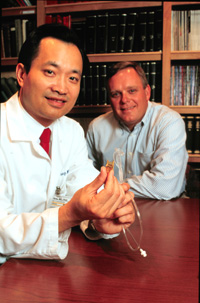
Dr. Ming Wang and patient Robert Jorman examine the new LASIK technology. (photo by Anne Rayner)
New LASIK technology enhances safety
VUMC is one of the first laser vision centers in the country to introduce a new generation of LASIK technology expected to reduce the number of post-operative infections, thus improving the safety of the procedure.
This new technology uses a disposable LASIK microkeratome, the part of the surgical instrument that slices a thin flap on the cornea that is then folded back to expose the corneal bed to the laser.
After the laser reshapes the corneal bed (to correct myopia, hyperopia or astigmatism), the flap is then flipped back in place on top of the eye so that the cornea heals properly.
Dr. Ming Wang, director of the Vanderbilt Laser Sight Center, was the principle investigator involved in the research and development of this new technology.
"One of the most feared complications after LASIK is infection of the eye, which can potentially damage the eye and result in the loss of vision. This is a particularly important consideration in an elective surgery such as LASIK," Wang said.
"What we hope to accomplish with this new generation of LASIK technology is to significantly reduce the number of infections, thus improving the level of safety of the procedure. It will raise the standard of care of laser vision correction to the next higher level.
"Even though the current microkeratomes are cleaned and sterilized after each use, there is still a chance of infection due to contamination from improper cleaning and sterilization, as well as damages due to repeated use. With this new disposable LASIK microkeratome, the LASIK surgeon is able to significantly cut down or eliminate the chance of contamination and infection," Wang said.
Earlier this month, Wang successfully performed one of the nation's first surgeries using the new LASIK instrument.
"Eventually this new instrument will become the standard of care for all LASIK vision correction surgeries worldwide," he said.
"It all comes down to the central issue of LASIK, which is safety. The development of a new and safer generation of LASIK technology gives us a whole new level of confidence in the quality of care that we deliver to our patients."













